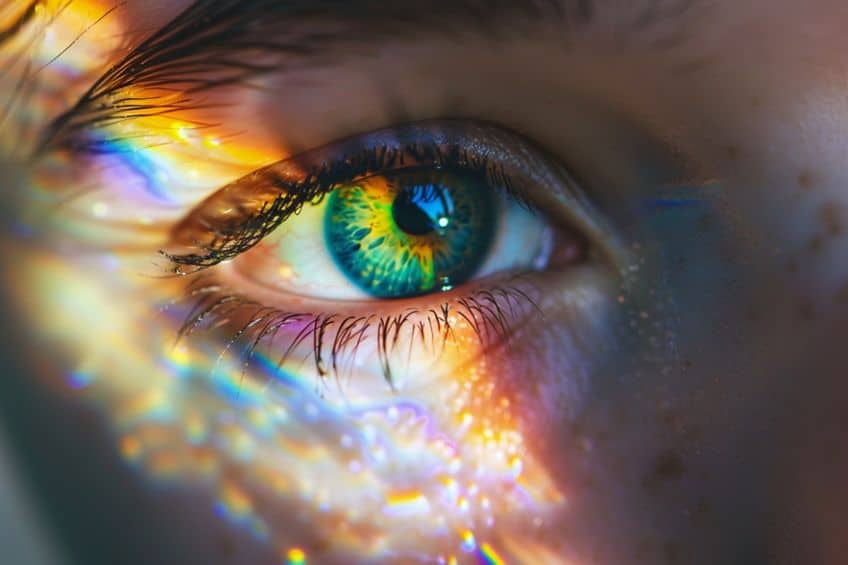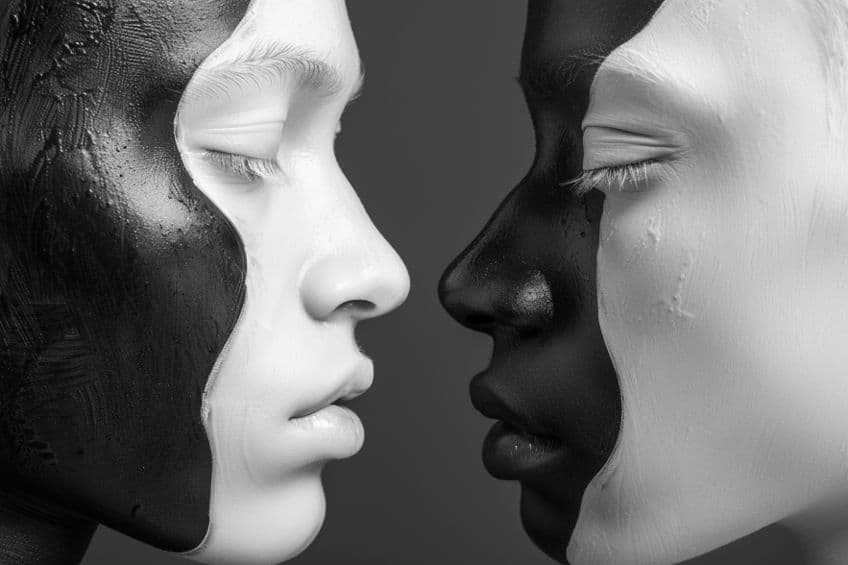Are Black and White Colors? – A Scientific Look at Color Theory
- Color perception involves both light physics and human visual interpretation.
- White is seen as a color when it combines all visible light wavelengths, while black is observed in the context of mixed pigments.
- Black and white serve as fundamental elements in artistic expression and design despite their unique status in the spectrum of visible light.
The Science of Color
The debate around whether black and white are considered colors is one that traverses the fields of physics, art, and human perception. In scientific terms, color is the result of light interacting with the human eye. Traditional physics posits that a color corresponds to a specific wavelength of visible light, and because black is the absence of light and white is a combination of all wavelengths of visible light, they are often described as non-colors or shades.

However, when considering the perception of colors, black and white do play significant roles. The human eye perceives color through the processing of light by photoreceptor cells in the retina. White light contains all the hues of the visible spectrum, making it integral to color vision. Black, while often viewed as the absence of light, becomes a color in its own right when pigments or dyes are mixed in art and design, offering a stark contrast and influence to the palette. The exploration of color in science encompasses the physical properties of light, the manner in which human vision interprets these signals, and the systems developed to reproduce color in technology and art.
Physics of Light and Color Perception
Color originates from electromagnetic energy—specifically, light—comprising wavelengths on the visible spectrum. These wavelengths range approximately between 380 and 750 nanometers. The perception of color occurs when light is reflected off objects and detected by the cones in the human eye. For instance, when all wavelengths are reflected, humans perceive the color white, whereas the absence of reflected light is perceived as black.
In the vibrant spectrum of visible light, each color paints its own unique wavelength canvas, captivating our senses and inspiring awe.
From the shortest wavelengths of violet at approximately 380–450 nm, through the tranquil blues spanning 450–495 nm, to the lush greens dancing between 495–570 nm, the spectrum unfolds in a symphony of hues. As our eyes journey further, they encounter the golden embrace of yellow at around 570–590 nm, the fiery allure of orange stretching to 590–620 nm, and finally, the passionate depths of red encompassing 620–750 nm. Together, these colors compose the kaleidoscope of our perception, illuminating the world with their radiant presence and inviting us to explore the boundless wonders of light.
Understanding Color Systems
Color systems explain how different methods are used to create colors in various mediums. The RGB (red, green, blue) color system is built on the additive color theory, relevant in digital displays and lighting, where colors are created by combining light itself. In contrast, the CMYK (cyan, magenta, yellow, black) system relies on the subtractive color theory, used in printing, where colors emerge from the absorption and reflection of light on surfaces.
- Additive Color Theory (RGB): Primary colors (red, green, blue) and secondary colors (cyan, magenta, yellow)
- Subtractive Color Theory (CMYK): Primary colors (cyan, magenta, yellow) and secondary colors (red, green, blue)

Human Color Vision
The human eye features three types of cones sensitive to different ranges of wavelengths, corresponding to red, green, and blue light. This allows humans to see a wide spectrum of colors by the combination of these primary colors’ intensities. The color wheel further helps to visualize how primary, secondary, and tertiary colors relate to one another, assisting in understanding how humans perceive color. In the intricate landscape of the human eye, three types of cones — S-Cones for short wavelengths, M-Cones for medium wavelengths, and L-Cones for long wavelengths — work in harmony to perceive the rich spectrum of colors.
These specialized receptors, each attuned to specific ranges of light, collaborate seamlessly to provide us with the wondrous tapestry of visual experiences that adorn our world.
Black and White in the Color Spectrum
| Shade | Hex Code | CMYK Color Code (%) | RGB Color Code | Color |
| Black | #000000 | 0, 0, 0, 100 | 0, 0, 0 | |
| White | #FFFFFF | 0, 0, 0, 0 | 255, 255, 255 |
In exploring the relationship between black, white, and the color spectrum, it is crucial to understand their definitions, how they are perceived by humans, and their applications in technology.

Defining Black and White
Black and white are often described as achromatic—lacking hue. Black represents the absence of light and is not found as a distinct color in the visible spectrum. It can be considered a shade that results from the absence of or complete absorption of light. Conversely, white is the culmination of all colors of light combined and is present when light is reflected without any absorption.
While they are neither hues nor found in the visible spectrum as individual wavelengths, black and white play crucial roles in the perception of color and brightness.
Black and White and Human Perception
Human vision distinguishes colors through light’s interaction with the eye’s photoreceptors. Black and white significantly influence this process as they define the extremes of brightness and contrast. Black objects absorb all light, thus contributing to minimal visual stimulation, while white objects reflect light across various wavelengths, providing maximal stimulation. The grayscale, ranging from pure black through various shades of gray to pure white, encompasses this entire spectrum of brightness without chromatic content.

Technological Utilization of Black and White
In technology and design, black and white are foundational. Designers and printers utilize them for contrast, legibility, and composition. Grayscale imagery, used extensively in various sectors such as photography and film, relies on the gradation of shades between black and white. In printing, black ink is crucial in the CMYK color model, providing depth and detail. In digital displays, an RGB model operates by enhancing brightness to create white and turning off all light to achieve black, thereby forming the basis for digital grayscale reproduction.
Both black and white are essential for creating visual hierarchy and establishing clear and effective communication through design and visual media.
Understanding Shades
In the discussion of color, shades play a crucial role in differentiating one hue from another by altering its brightness or darkness. This section will explore the nuances of shades and specifically examine black and white’s relationship with this concept.

Shade Versus Color
Shade technically refers to a color that has had black added to it to make it darker. In contrast, a color is an aspect of light that is visible to the human eye and can be described in terms of hue, saturation, and brightness. Colors are the base from which shades are derived.
For example, pure red signifies a color, while burgundy, a darker variant, represents a shade.
How Does Black and White Fit Into This?
Black and white challenge traditional color definitions. Black is absent of light, and as such, in the additive color model, it is not considered a color due to its light-absorbing characteristics. White, however, is produced by the combination of all colors of light, making it a color in the additive model.
- Black objects absorb all colors and reflect none.
- White objects reflect all colors in the spectrum.
In pigment (subtractive color model), black can be seen as a color since it can be produced by mixing other pigments. Nevertheless, in a pure scientific sense, black is a shade and not a color.

Color in Art and Design
Exploring the nuances of color in art and design reveals the essential roles black and white play, their psychological effects, and how they influence color theory and practice. Black and white serve as fundamental elements in an artist’s palette, often categorized as shades rather than pure colors due to their association with light absence or the full spectrum of visible light. In grayscale, artists manipulate value and contrast without the influence of hue, focusing on elements like form, texture, and composition. When black pigment is combined with others, it creates shades and depth, whereas white, used in tints and highlights, can affect the perception of space and volume within a composition.
Designers leverage this achromatic color scheme to establish clarity and focus.
- Use in color palettes: Defines boundaries and enhances neighboring colors
- Grayscale: Utilized for focusing on contrast and tonal values
- Contrast: Black and white create the highest contrast, drawing attention and guiding viewers.
Psychological Impact of Colors
Colors elicit psychological responses and carry cultural connotations, influencing mood and behavior. Designers and artists carefully choose color palettes to convey messages and evoke emotions. Warm colors often inspire feelings of warmth and comfort, while cool colors might evoke calm or serenity. Achromatic designs, utilising blacks, whites, and grays, can convey a range of tones and moods—from the stark and serious to the dynamic and expressive.
- Warm colors: Include reds, oranges, and yellows; associated with energy and passion.
- Cool colors: Incorporate blues, greens, and purples; often relay calmness and professionalism.

By manipulating the color temperature and saturation—whether through pigments in paint or dye, or digitally in RGB color schemes—artists and designers impact an artwork’s overall feel and readability. They apply color theory to construct compelling color schemes, using neutral tones for balance and employing contrast to direct viewer attention and highlight key elements of the design.
In the kaleidoscope of color theory, the inquiry into whether black and white qualify as colors may seem like a riddle without a definitive answer. Yet, as we’ve explored their intricate interplay with light, pigments, and perception, one thing becomes abundantly clear: black and white transcend mere definitions. They are the yin and yang of our visual universe, embodying contrast, harmony, and boundless potential for artistic expression. So, the next time you ponder the question, remember that in the palette of creativity, black and white wield their own vibrant shades of significance, coloring our world with richness and depth. Embrace the mystery, celebrate the diversity, and let your imagination splash the canvas of existence with the timeless allure of black, white, and everything in between!
Frequently Asked Questions
Is White Considered a Color or a Shade?
White is regarded as a color in the context of additive color mixing, where it results from the combination of all wavelengths of visible light. It is seen when an object reflects all parts of the visible spectrum, giving the appearance of white.
Why Are Black and White Traditionally Not Classified As Colors?
Traditionally, black and white are not categorized as colors because they do not fit neatly into the color spectrum. Black is often thought of as the absence of visible light, whereas white is the combination of all colors of light in the additive color model. Thus, they are sometimes referred to as achromatic, meaning without color.
Can Black Be Described As the Presence or Absence of Color?
In terms of light, black can be described as the absence of color, as it is what the human eye perceives when no visible light reaches the retina. However, when considering pigments or dyes, black is created by combining multiple colors, so it can be considered the presence of all pigment colors.
In 2005, Charlene completed her Wellness Diplomas in Therapeutic Aromatherapy and Reflexology from the International School of Reflexology and Meridian Therapy. She worked for a company offering corporate wellness programs for a couple of years, before opening up her own therapy practice. It was in 2015 that a friend, who was a digital marketer, asked her to join her company as a content creator, and this is where she found her excitement for writing.
Since joining the content writing world, she has gained a lot of experience over the years writing on a diverse selection of topics, from beauty, health, wellness, travel, and more. Due to various circumstances, she had to close her therapy practice and is now a full-time freelance writer. Being a creative person, she could not pass up the opportunity to contribute to the Art in Context team, where is was in her element, writing about a variety of art and craft topics. Contributing articles for over three years now, her knowledge in this area has grown, and she has gotten to explore her creativity and improve her research and writing skills.
Charlene Lewis has been working for artincontext.org since the relaunch in 2020. She is an experienced writer and mainly focuses on the topics of color theory, painting and drawing.
Learn more about Charlene Lewis and the Art in Context Team.
Cite this Article
Charlene, Lewis, “Are Black and White Colors? – A Scientific Look at Color Theory.” Art in Context. March 11, 2024. URL: https://artincontext.org/are-black-and-white-colors/
Lewis, C. (2024, 11 March). Are Black and White Colors? – A Scientific Look at Color Theory. Art in Context. https://artincontext.org/are-black-and-white-colors/
Lewis, Charlene. “Are Black and White Colors? – A Scientific Look at Color Theory.” Art in Context, March 11, 2024. https://artincontext.org/are-black-and-white-colors/.









